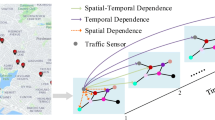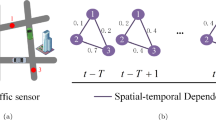Abstract
Accurate traffic flow prediction is essential for developing intelligent transportation systems (ITS) and providing real-time traffic applications. This study proposes a novel Spatial-Temporal Graph Neural Network based on Gated Convolution and Topological Attention (STGNN-GCTA) to accurately model complex spatiotemporal traffic flow correlations. In the temporal dimension, we design a novel Gated-Memory Convolutional Neural Network (GMCNN) to capture the non-linear temporal dependencies by controlling the output based on the timing information position. In the spatial dimension, we develop a Multilayer Graph Topological Attention Network (MGTAN) to capture the dynamic spatial dependencies by identifying high-impact neighborhood segments in each time step. In particular, we improve the model’s prediction robustness in a noisy environment using the Network Smoothing Training (NST) method. Experimental results on two public traffic datasets demonstrate that STGNN-GCTA has higher prediction accuracy and execution efficiency than baseline methods and exhibits excellent robustness.


















Similar content being viewed by others
Data Availability
The datasets generated during and analyzed during the current study are available from the corresponding author on reasonable request.
References
Kaffash S, Nguyen AT, Zhu J (2021) Big data algorithms and applications in intelligent transportation system: A review and bibliometric analysis. Int J Prod Econ 231:107868
McGowan CJ, Biggerstaff M, Johansson M, Apfeldorf KM, Ben-Nun M, Brooks L, Convertino M, Erraguntla M, Farrow DC, Freeze J et al (2019) Collaborative efforts to forecast seasonal influenza in the united states, 2015–2016. Sci Rep 9(1):683
Jamil R (2020) Hydroelectricity consumption forecast for pakistan using ARIMA modeling and supply-demand analysis for the year 2030. Renew Energy 154:1–10
Boukerche A, Wang J (2020) Machine learning-based traffic prediction models for intelligent transportation systems. Comput Netw 181:107530
Wang S, Cao J, Philip SY (2022) Deep learning for spatio-temporal data mining: A survey. IEEE Trans Knowl Data Eng 34(08):3681–3700
Assaf AG, Li G, Song H, Tsionas MG (2019) Modeling and forecasting regional tourism demand using the bayesian global vector autoregressive (BGVAR) model. J Travel Res 58(3):383–397
Xia D, Wang B, Li H, Li Y, Zhang Z (2016) A distributed spatial-temporal weighted model on mapreduce for short-term traffic flow forecasting. Neurocomputing 179:246–263
Tang J, Chen X, Hu Z, Zong F, Han C, Li L (2019) Traffic flow prediction based on combination of support vector machine and data denoising schemes. Phys A Stat Mech Appl 534:120642
Liu X, Zhu X, Li M, Wang L, Zhu E, Liu T, Kloft M, Shen D, Yin J, Gao W (2020) Multiple kernel \(k\)-means with incomplete kernels. IEEE Trans Patt Anal Mach Intell 42(5):1191–1204
Yu X, Ye X, Zhang S (2022) Floating pollutant image target extraction algorithm based on immune extremum region. Digit Sig Process 123:103442
Zhou Z, Zhang B, Yu X (2022) Immune coordination deep network for hand heat trace extraction. Infrared Phys Technol 127:104400
Sherstinsky A (2020) Fundamentals of recurrent neural network (RNN) and long short-term memory (LSTM) network. Physica D: Nonlinear Phenomena 404:132306
Cho K, Van Merriënboer B, Gulcehre C, Bahdanau D, Bougares F, Schwenk H, Bengio Y (2014) Learning phrase representations using RNN encoder-decoder for statistical machine translation. In: Proc. of EMNLP, pp 1724–1734
Ma X, Tao Z, Wang Y, Yu H, Wang Y (2015) Long short-term memory neural network for traffic speed prediction using remote microwave sensor data. Transport Res Part C Emerg Tech 54:187–197
Sutskever I, Vinyals O, Le VQ (2014) Sequence to sequence learning with neural networks. Adv Neural Inf Process Syst 27:3104–3112
Yang D, Chen K, Yang M, Zhao X (2019) Urban rail transit passenger flow forecast based on LSTM with enhanced long-term features. IET Intell Transp Syst 13(10):1475–1482
Xia D, Zhang M, Yan X, Bai Y, Zheng Y, Li Y, Li H (2021) A distributed WND-LSTM model on mapreduce for short-term traffic flow prediction. Neural Comput & Applic 33(7):2393–2410
Chu K-F, Lam AY, Li VO (2019) Deep multi-scale convolutional LSTM network for travel demand and origin-destination predictions. IEEE Trans Intell Transp Syst 21(8):3219–3232
Bengio Y, Simard P, Frasconi P (1994) Learning long-term dependencies with gradient descent is difficult. IEEE Trans Neural Netw 5(2):157–166
Bai S, Kolter JZ, Koltun V (2018) Convolutional sequence modeling revisited. In: Proc. of ICLR, pp 1–20
Lea C, Flynn MD, Vidal R, Reiter A, Hager GD (2017) Temporal convolutional networks for action segmentation and detection. In: Proc. of CVPR, pp 156–165
Yu F, Koltun V, Funkhouser TA (2017) Dilated residual networks. In: Proc. of CVPR, pp 636–644
Yao H, Tang X, Wei H, Zheng G, Li Z (2019) Revisiting spatial-temporal similarity: A deep learning framework for traffic prediction. Proc. of AAAI 33:5668–5675
Liu Y, Yu JJQ, Kang J, Niyato D, Zhang S (2020) Privacy-preserving traffic flow prediction: A federated learning approach. IEEE Internet Things J 7(8):7751–7763
Zhou J, Cui G, Hu S, Zhang Z, Yang C, Liu Z, Wang L, Li C, Sun M (2020) Graph neural networks: A review of methods and applications. AI Open 1:57–81
Jiang Z (2018) A survey on spatial prediction methods. IEEE Trans Knowl Data Eng 31(9):1645–1664
Veličković P, Cucurull G, Casanova A, Romero A, Liò P, Bengio Y (2018) Graph attention networks. In: Proc. of ICLR, pp 1–12
Anava O, Hazan E, Zeevi A (2015) Online time series prediction with missing data. In: Proc. of ICML, pp 2191–2199
Zhang J, Wang F-Y, Wang K, Lin W-H, Xu X, Chen C (2011) Data-driven intelligent transportation systems: A survey. IEEE Trans Intell Transport Syst 12(4):1624–1639
Liu J, Ong GP, Chen X (2020) Graphsage-based traffic speed forecasting for segment network with sparse data. IEEE Trans Intell Transport Syst 23(3):1755–1766
Li Y, Zheng Y (2019) Citywide bike usage prediction in a bike-sharing system. IEEE Trans Knowl Data Eng 32(6):1079–1091
Zhang J, Zheng Y, Sun J, Qi D (2019) Flow prediction in spatio-temporal networks based on multitask deep learning. IEEE Trans Knowl Data Eng 32(3):468–478
Mulder WD, Bethard S, Moens MF (2015) A survey on the application of recurrent neural networks to statistical language modeling. Comp Speech Lang 30(1):61–98
Dauphin YN, Fan A, Auli M, Grangier D (2017) Language modeling with gated convolutional networks. In: Proc. of ICML, pp 933–941
Landi F, Baraldi L, Cornia M, Cucchiara R (2021) Working memory connections for LSTM. Neural Networks 144:334–341
Huang X, Ye Y, Wang C, Yang X, Xiong L (2022) A multi-mode traffic flow prediction method with clustering based attention convolution LSTM. Appl Intell 52(13):14773–14786
Davis N, Raina G, Jagannathan K (2020) Grids versus graphs: Partitioning space for improved taxi demand-supply forecasts. IEEE Trans Intell Transport Sys 22(10):6526–6535
Yusuf AA, Chong F, Xianling M (2022) An analysis of graph convolutional networks and recent datasets for visual question answering. Artif Intell Rev 55(8):6277–6300
Yu B, Yin H, Zhu Z (2018) Spatio-temporal graph convolutional networks: A deep learning framework for traffic forecasting. In: Proc. of IJCAI, pp 3634–3640
Li Y, Yu R, Shahabi C, Liu Y (2018) Diffusion convolutional recurrent neural network: Data-driven traffic forecasting. In: Proc. of ICLR, pp 1–16
Wu Z, Pan S, Long G, Jiang J, Zhang C (2019) Graph wavenet for deep spatial-temporal graph modeling. In: Proc. of IJCAI, pp 1907–1913
Zhang J, Chen F, Guo Y, Li X (2020) Multi-graph convolutional network for short-term passenger flow forecasting in urban rail transit. IET Intell Trans Sys 14(10):1210–1217
Zhao L, Song Y, Zhang C, Liu Y, Wang P, Lin T, Deng M, Li H (2020) T-GCN: A temporal graph convolutional network for traffic prediction. IEEE Trans Intell Transport Syst 21(9):3848–3858
Kong X, Zhang J, Wei X, Xing W, Lu W (2022) Adaptive spatial-temporal graph attention networks for traffic flow forecasting. Appl Intell 52(4):4300–4316
Qi T, Li G, Chen L, Xue Y (2022) ADGCN: An asynchronous dilation graph convolutional network for traffic flow prediction. IEEE Internet Things J 9(5):4001–4014
Zhou F, Yang Q, Zhong T, Chen D, Zhang N (2021) Variational graph neural networks for road traffic prediction in intelligent transportation systems. IEEE Trans Ind Inf 17(4):2802–2812
Luo D, Zhao D, Ke Q, You X, Liu L, Ma H (2022) Spatiotemporal hashing multigraph convolutional network for service-level passenger flow forecasting in bus transit systems. IEEE Internet Things J 9(9):6803–6815
Huang X, Ye Y, Ding W, Yang X, Xiong L (2022) Multi-mode dynamic residual graph convolution network for traffic flow prediction. Inf Sci 609:548–564
Cao S, Wu L, Wu J, Wu D, Li Q (2022) A spatio-temporal sequence-to-sequence network for traffic flow prediction. Inf Sci 610:185–203
Do LN, Vu HL, Vo BQ, Liu Z, Phung D (2019) An effective spatial-temporal attention based neural network for traffic flow prediction. Transport Res Part C Emerg Technol 108:12–28
Guo S, Lin Y, Feng N, Song C, Wan H (2019) Attention based spatial-temporal graph convolutional networks for traffic flow forecasting. Proc. of AAAI 33:922–929
Pan Z, Liang Y, Wang W, Yu Y, Zheng Y, Zhang J (2019) Urban traffic prediction from spatio-temporal data using deep meta learning. In: Proc. of KDD, p 1720–1730
Zheng C, Fan X, Wang C, Qi J (2020) GMAN: A graph multi-attention network for traffic prediction. Proc. of AAAI 34:1234–1241
Wang Y, Jing C, Xu S, Guo T (2022) Attention based spatiotemporal graph attention networks for traffic flow forecasting. Inf Sci 607:869–883
Zhang X, Huang C, Xu Y, Xia L, Dai P, Bo L, Zhang J, Zheng Y (2021) Traffic flow forecasting with spatial-temporal graph diffusion network. Proc. of AAAI 35:15008–15015
Lu B, Gan X, Jin H, Fu L, Wang X, Zhang H (2022) Make more connections: Urban traffic flow forecasting with spatiotemporal adaptive gated graph convolution network. ACM Trans Intell Syst Tech 13(2):1–25
He K, Zhang X, Ren S, Sun J (2015) Delving deep into rectifiers: Surpassing human-level performance on imagenet classification. In: Proc. of ICCV, pp 1026–1034
Vaswani A, Shazeer N, Parmar N, Uszkoreit J, Jones L, Gomez AN, Kaiser L, Polosukhin I (2017) Attention is all you need. In: Proc. of NeurIPS, pp 5998–6008
Liu S, Zhang X, Xu L, Ding F (2022) Expectation-maximization algorithm for bilinear systems by using the Rauch-Rung-Striebel smoother. Automatica 142:110365
Chiang K-W, Tsai G-J, Chang H, Joly C, Ei-Sheimy N (2019) Seamless navigation and mapping using an INS/GNNS/grid-based slam semi-tightly coupled integration scheme. Inf Fusion 50:181–196
Liu H, Nassar S, El-Sheimy N (2010) Two-filter smoothing for accurate INS/GPS land-vehicle navigation in urban centers. IEEE Trans Veh Technol 59(9):4256–4267
Seo T (2020) Calibration-free traffic state estimation method using single detector and connected vehicles with kalman filtering and RTS smoothing. In: Proc. of ITSC, pp 1–5
Chen C, Petty K, Skabardonis A, Varaiya P, Jia Z (2001) Freeway performance measurement system: Mining loop detector data. Transport Res Rec 1748(1):96–102
Loshchilov I, Hutter F (2019) Decoupled weight decay regularization. In: Proc. of ICLR, pp 1–8
Acknowledgements
This work was supported in part by the National Natural Science Foundation of China (Grant nos. 62162012, 62173278, and 62072061), the High-Level Innovative Talent Project of Guizhou Province (Grant no. QKHPTRC-GCC2023027), the Science and Technology Support Program of Guizhou Province (Grant no. QKHZC2021YB531), the Natural Science Research Project of Department of Education of Guizhou Province (Grant nos. QJJ2022015, QJJ2022047, QJJ2023012, and QJJ2023061), the Science and Technology Foundation of Guizhou Province (Grant nos. QKHJCZK2022YB197 and QKHJCZK2023YB143), the Youth Science and Technology Talents Development Project of Guizhou (Grant no. QJHKY2022175), and the Scientific Research Platform Project of Guizhou Minzu University (Grant no. GZMUSYS202104).
Author information
Authors and Affiliations
Corresponding authors
Ethics declarations
Competing interest
The authors declare that they have no known competing financial interests or personal relationships that could have appeared to influence the work reported in this paper.
Additional information
Publisher's Note
Springer Nature remains neutral with regard to jurisdictional claims in published maps and institutional affiliations.
Rights and permissions
Springer Nature or its licensor (e.g. a society or other partner) holds exclusive rights to this article under a publishing agreement with the author(s) or other rightsholder(s); author self-archiving of the accepted manuscript version of this article is solely governed by the terms of such publishing agreement and applicable law.
About this article
Cite this article
Bai, D., Xia, D., Huang, D. et al. Spatial-temporal graph neural network based on gated convolution and topological attention for traffic flow prediction. Appl Intell 53, 30843–30864 (2023). https://doi.org/10.1007/s10489-023-05053-x
Accepted:
Published:
Issue Date:
DOI: https://doi.org/10.1007/s10489-023-05053-x




